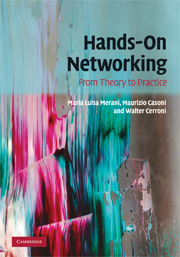7 - Routing fundamentals and protocols
Published online by Cambridge University Press: 05 June 2012
Summary
In Chapter 6, the main functions and architectures of routers have been presented and discussed. Routers are the basic active devices employed in networks and their fundamental task is to forward packets from node to node toward their final destination, taking the most adequate decisions concerning the network path to follow [65]. More specifically, routers perform three main functions: routing table creation and update, table look-up for forwarding decision and physical datagram forwarding from input ports to output ports.
The first of these functions is called routing and consists of running algorithms and implementing protocols suitable to the specific routing problem and network topology size [81].On the one hand, routing algorithms are executed to create and maintain routing tables, once sufficient information about the network topology has been gathered. On the other hand, routing protocols are employed between routers to exchange the network topology information necessary for executing the algorithms.
This chapter illustrates the basic principles of routing, describing the most important algorithms and protocols. The hierarchical approach to the routing problem adopted by the Internet is also discussed, including a brief overview of the most popular IP routing protocols, namely RIP and OSPF. A couple of practical examples of IP routing configurations conclude the chapter.
Routing algorithms
Routing algorithms are characterized by the way the routing table is created and possibly updated. Generally speaking, such an algorithm should be correct, fair, stable, optimal, fast, simple, and adaptive to network topology changes and to traffic conditions. It is evidently difficult to meet all these requirements with just a single, ideal algorithm, so any real routing algorithm usually provides a trade-off on some of them.
Information
- Type
- Chapter
- Information
- Hands-On NetworkingFrom Theory to Practice, pp. 187 - 219Publisher: Cambridge University PressPrint publication year: 2009
